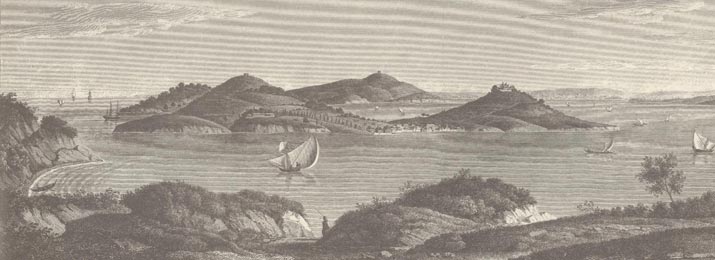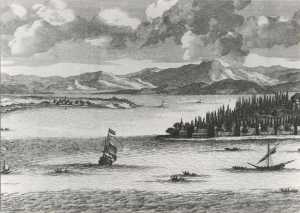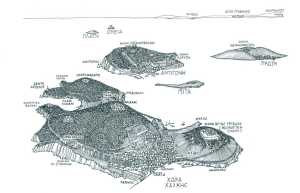From the Voyagers' Journals
- Details
- Created on 17 February 2013
- Last Updated on 01 April 2013

The Turkish chronicler Evliya Çelebi, author of the Seyahatname, or Chronicle of Travels, writes of two voyages that he and his companions made to the islands in 1640 (AH 1050), the first of which took them from the Bosphorus to Heybeli on their way to Bursa:
We weighed anchor at Emirgan on the Bosphorus, and called at F›nd›kl› to take on board as passengers some clever ship-builders; and in the morning on the first Friday of Moharrem of the year 1050, the boatmen finding the time favorable for sailing, unfurled the sails and weathered Seraglio Point; laying the ship’s head toward Bursa, the object of our voyage. All the passengers were in high spirits, and some of them implored the Lord’s assistance for a happy voyage by singing spiritual songs. Some musicians encourged me to accompany them in their strains, and so...I fixed on the measure girdanieh, and sang three tetrasticks and one sumayi of the compositions of Dervish Omerbestieh. Some of the boatmen accompanied us on their instruments, chokur, with such effect, that water came into the mouths of the hearers with delight. Amidst these amusements we came to the isle of Heybeli, eighteen miles from Constantinople and nine in circumference. It contains a famous convent which is visited every year by many boats from Constantinople. The inhabitants are all wealthy Greeks, captains and masters of ships....
Evliya’s estimate of the circumference of Heybeliada is far too large, an exaggeration he also makes in giving the sizes of the other isles in describing another voyage he made later that same year:
 “We embarked for the island of Heybeli... which we have already mentioned. Six miles farther on is the island of Tavshanli [Rabbit or Hare Istand], which derives its name from the infinite number of hares found there; it is only one mile in circumference, and is uncultivated. After rowing eight miles we came to the island of Burgaz with a small but strong castle, situated on the chalk cliff by the seashore. The island is eleven miles in circumference, and... it has three hundred houses with fine gardens and good wells.... The inhabitants are all Greeks, and are rich masters of boats. The island abounds in goats and hares. Kınalı is eight miles in circumference, has a convent and a village of one hundred Greek houses. Ten miles distant from it is Büyükada, a cultivated island twenty miles in circumference, with a village of two hundred Greek houses. On its four sides there are dalyans, lookouts for catching fish.
“We embarked for the island of Heybeli... which we have already mentioned. Six miles farther on is the island of Tavshanli [Rabbit or Hare Istand], which derives its name from the infinite number of hares found there; it is only one mile in circumference, and is uncultivated. After rowing eight miles we came to the island of Burgaz with a small but strong castle, situated on the chalk cliff by the seashore. The island is eleven miles in circumference, and... it has three hundred houses with fine gardens and good wells.... The inhabitants are all Greeks, and are rich masters of boats. The island abounds in goats and hares. Kınalı is eight miles in circumference, has a convent and a village of one hundred Greek houses. Ten miles distant from it is Büyükada, a cultivated island twenty miles in circumference, with a village of two hundred Greek houses. On its four sides there are dalyans, lookouts for catching fish.
The beauty of the Princes’ Isles and the rather grim historical associations of its royal exiles appealed to the romantic imagination of the nineteenth century. This aspect of the islands is evoked in a purple passage at the beginning of Gustave Schlumberger’s charming book Les Iles des Princes, first published in 1884:
 "Naples has its Capri and its Ischia: Constantinople its Princes’ Isles. The Neapolitan is not more proud of the jewels that adorn his bay than is the Greek of Pera of his charming islands, places of repose and pleasure, that raise their enchanting silhouettes at the entrance to the Sea of Marmara. Just as the crimes of Tiberius almost as much as the splendors of nature have made Capri famous, so the gloomy adventures of emperors, empresses and all the exiles of high rank, relegated to the convents of Proti, Antigoni, and Prinkipo as well as a result of the revolutions with which the history of Byzantium bristles, have made these radiant islands one of the most tragic sites of the ancient world. No corner of the earth is more fertile in stories of lamentable catastrophes, in poignant lessons in the vanity of human grandeur. From this point of view alone the Princes’ Isles would deserve a visit from the historian and the thinker. Few places here below have witnessed the groans of more princes and princesses hurled from the splendors of the Imperial Palace to the depths of a cell in some imperial monastery. Add to these moving souvenirs the fact that this archipelago in miniature possesses beauties designed to ravish an eye sated with the marvels of Italy and Sicily, that nowhere does the delighted eye repose on coasts more lovely, on a bay more gracious, on mountainous distances more grandiose; that nowhere is the verdure fresher or more varied; that nowhere in short do bluer waters bathe more gently a thousand shady coves, a thousand poetic cliffs; you will then understand why the Princes’ Isles, bedewed of yore with so many tears, vaunted today with so much praise, are a favorite place of pilgrimage for all those who are attracted by the study of a dramatic past or the charm of a smiling present.
"Naples has its Capri and its Ischia: Constantinople its Princes’ Isles. The Neapolitan is not more proud of the jewels that adorn his bay than is the Greek of Pera of his charming islands, places of repose and pleasure, that raise their enchanting silhouettes at the entrance to the Sea of Marmara. Just as the crimes of Tiberius almost as much as the splendors of nature have made Capri famous, so the gloomy adventures of emperors, empresses and all the exiles of high rank, relegated to the convents of Proti, Antigoni, and Prinkipo as well as a result of the revolutions with which the history of Byzantium bristles, have made these radiant islands one of the most tragic sites of the ancient world. No corner of the earth is more fertile in stories of lamentable catastrophes, in poignant lessons in the vanity of human grandeur. From this point of view alone the Princes’ Isles would deserve a visit from the historian and the thinker. Few places here below have witnessed the groans of more princes and princesses hurled from the splendors of the Imperial Palace to the depths of a cell in some imperial monastery. Add to these moving souvenirs the fact that this archipelago in miniature possesses beauties designed to ravish an eye sated with the marvels of Italy and Sicily, that nowhere does the delighted eye repose on coasts more lovely, on a bay more gracious, on mountainous distances more grandiose; that nowhere is the verdure fresher or more varied; that nowhere in short do bluer waters bathe more gently a thousand shady coves, a thousand poetic cliffs; you will then understand why the Princes’ Isles, bedewed of yore with so many tears, vaunted today with so much praise, are a favorite place of pilgrimage for all those who are attracted by the study of a dramatic past or the charm of a smiling present.
Edwin Grosvenor gives an equally impassioned description of the islands and their lugubrious history in his Constantinople, published in 1895:
 Nature, insatiable in giving, has diversified the capital not only with the Bosphorus and the Golden Horn, but with the tiny archipelago of the Princes’ Isles. More than Ischia and Capri are to Naples, are Khalki, Prinkipo and their sister islands to Constantinople. They are far less remote from the municipal centre, and form an integral part of the city. The nearest is but four miles distant from Kadikeui, and only little farther from Stamboul.
Nature, insatiable in giving, has diversified the capital not only with the Bosphorus and the Golden Horn, but with the tiny archipelago of the Princes’ Isles. More than Ischia and Capri are to Naples, are Khalki, Prinkipo and their sister islands to Constantinople. They are far less remote from the municipal centre, and form an integral part of the city. The nearest is but four miles distant from Kadikeui, and only little farther from Stamboul.
They were anciently called Demonesoi, from a legendary or historic Demonesos, who worked in their stone and metal. Their mediaeval name, Papadanesoi, the islands of the Priests, and the modern name, Princes’ Isles, through the irony of history, have a common meaning and association. During the Byzantine Middle Ages, the monastery was not far distant from the throne. He who, in the evening, wore the imperial golden circlet upon his long and plaited locks might on the morrow, with shaven head, become the unwilling inmate of a monastic cell. In those days, the islands were seldom sought for pleasure, but were abandoned to monasteries and monks. Hither many a deposed sovereign was exiled, whom, stripped of all that made life desirable, the disdain or humanity of his successor permitted to live. Not one of all the discarded emperors imprisoned here, with cowl and cloak, ever went back to his throne. Though almost all the monasteries have crumbled, and only a few inmates wander over the grass-grown paths, the tradition of deposed princes has survived and bestowed upon the islands their present name.
 They are nine in number. Two, Pita and Neandros, are destitute of inhabitant or interest. Three, Oxeia, Pita and Antirovithos, are isolated from the present, but have each their history of failure and sorrow. Four, Proti, Antigone, Khalki, and Prinkipo, are the chief. They are in daily steam communication with one another and with the other quarters of the capital. The mildness and regularity of their climate render them the healthiest locality in the Empire. Nowhere else along the northern Marmora does the olive tree grow with such profusion, or yield more generous results. Nothing more ideal can be pictured than the loveliness of these islands in May and June. The hills are covered with pine forests, and the meandering shores are indented with shaded and sequestered bays. Wherever the gaze is turned, beauty confronts the eye. Yet in winter they are almost deserted. The treacherous Marmora suddenly and often cuts off all communication with the outer world. Then, though at sunset the shadow of Stamboul seems to fall upon them, they are practically many leagues away.
They are nine in number. Two, Pita and Neandros, are destitute of inhabitant or interest. Three, Oxeia, Pita and Antirovithos, are isolated from the present, but have each their history of failure and sorrow. Four, Proti, Antigone, Khalki, and Prinkipo, are the chief. They are in daily steam communication with one another and with the other quarters of the capital. The mildness and regularity of their climate render them the healthiest locality in the Empire. Nowhere else along the northern Marmora does the olive tree grow with such profusion, or yield more generous results. Nothing more ideal can be pictured than the loveliness of these islands in May and June. The hills are covered with pine forests, and the meandering shores are indented with shaded and sequestered bays. Wherever the gaze is turned, beauty confronts the eye. Yet in winter they are almost deserted. The treacherous Marmora suddenly and often cuts off all communication with the outer world. Then, though at sunset the shadow of Stamboul seems to fall upon them, they are practically many leagues away.
Scattered in the sea southeast of the Bosphorus, their rounded forms present a vision of delight. Looked upon from the west, the four chief islands lie spread upon the horizon as if blent in one. Still nearer on the right, Oxeia the Lofty lifts its towering, cone-like rock; while Plati the Flat emerges little above the surface of the water.
The Princes’ Isles are still as beautiful and romantic as Schlumberger and Grosvenor describe them, floating in the mirroring water off the Asian coast of the Marmara between the pale blues of sea and sky, places of refuge and exile from the turbulent megalopolis on the Bosphorus.


 History
History 